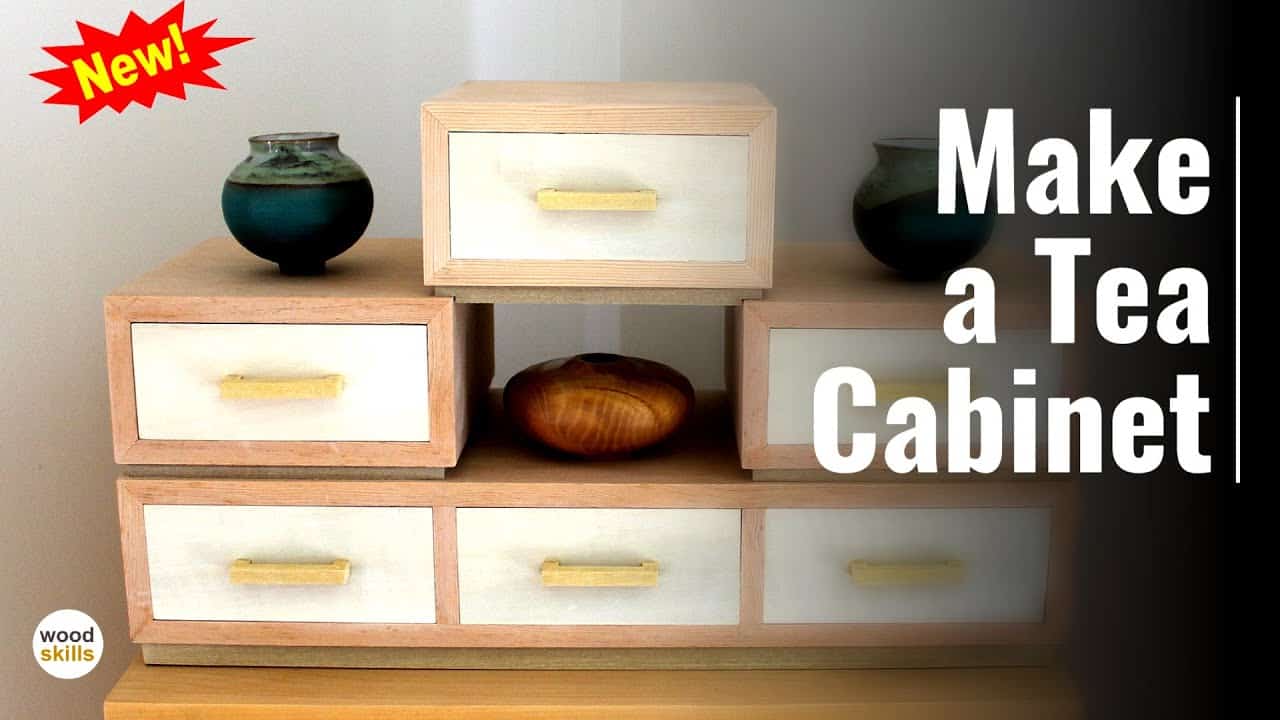Norman Pirollo from WoodSkills built and designed the tea cabinet project featured in this video.
The video presents a series of contemporary tea cabinets with waterfall grain, precise case-miter joinery, and carefully fitted drawers, focusing on a three-level design that adds a central raised compartment as a focal point.
Watch the full video and subscribe to WoodSkills:
Design
The tea cabinet series features compact contemporary proportions and a strong visual motif created by waterfall grain wrapping around the case miters. Norman designed three variations: two two-level versions with different offsets and a more elaborate three-level model that raises the central compartment to create an open reveal and a dramatic focal point.
The design balances function and aesthetics by combining multiple small drawers with display platforms for cups or decorative items, producing a versatile object that can serve many uses beyond tea storage.
Lumber Prep & Wood Selection
Careful board selection is central to achieving the waterfall grain effect, so Norman emphasizes choosing rift-sawn or sequential boards that will produce continuous grain across corners. He pairs light-toned woods for the main cases with darker separators to create contrast and define the reveals around each compartment.
Milling, grain matching, and acclimating boards before layout are highlighted as essential preparation steps to minimize surprises during glue-up and to keep the waterfall graphics consistent around the cabinet.
Case Miters & Joinery
Long, precise case miters are the defining joinery method for the waterfall corners, and Norman explains specialized techniques to cut and fit miters over extended lengths without losing alignment. He covers layout strategies and shop practices developed to maintain matching grain and tight seams when working with miters that wrap from face to side.
Internally, the cabinet uses dados and lengthwise mortises to locate vertical dividers and drawer partitions, with attention to knife-sharp layout so the reveals remain consistent and components register accurately during assembly.
Drawer Fitting & Internal Layout
The build includes multiple drawers arranged in matching pairs so that components can be made in multiples and swapped interchangeably, simplifying construction and maintenance. Norman discusses drawer bottoms, drawer stops, and back-panel rabbets, stressing how small errors in layout—an eighth of an inch or less—are visually noticeable and must be avoided.
Approaches to sizing and spacing prioritize consistent drawer depths while allowing flexibility in width, giving builders the option to adapt the cabinet to available board sizes or personal requirements without upsetting the overall visual rhythm.
Assembly, Clamping & Handling Wood Movement
Assembly techniques focus on keeping the waterfall edges aligned while managing wood movement; for example, the base is built up from multiple mitered pieces rather than a single solid block to accommodate seasonal changes. Norman also explains how to prepare and fit back panels and how to sequence glue-ups to preserve precision across the long miters.
Practical clamping and trimming strategies include using hand tools—planes, a shooting board, and a bench hook—to refine small parts, combined with power tools like a band saw for rough cutting when appropriate.
Finishing & Final Touches
Finishing considerations revolve around preserving the visual contrast between the light case wood and the darker separators, as well as softening edges and designing custom pulls that complement the cabinet’s aesthetic. Norman designs simple, elegant handles and shows how small reveal details and pulls can elevate the overall composition.
The final fit and alignment of drawer fronts and pulls receives special attention, and Norman provides methods for achieving consistent spacing so the cabinet reads as a unified object rather than a collection of parts.
Why This Tea Cabinet Matters
The tea cabinet project is a compact study in grain matching, precision joinery, and component layout, making it a strong learning piece for builders who want to practice case miters and fitting small drawers. Norman’s approach emphasizes planning, repeatable components, and techniques that transfer to larger furniture work.
By grouping the build into design, prep, joinery, and finishing themes rather than a strict step-by-step, the project becomes adaptable and useful as a template for other small cabinets and decorative boxes.
Want to build this? Check out Norman’s course: https://www.woodskills.com/tea-cabinet-course
